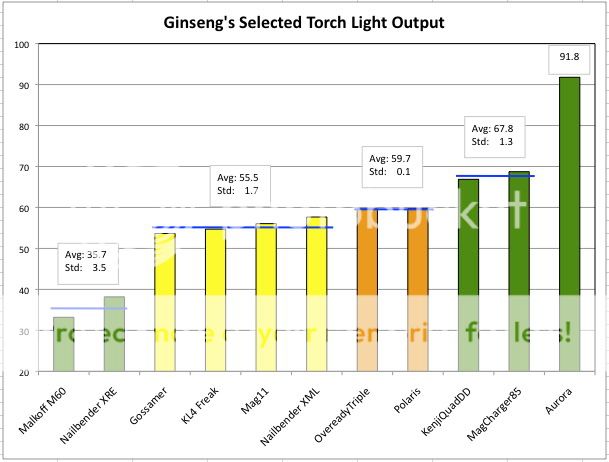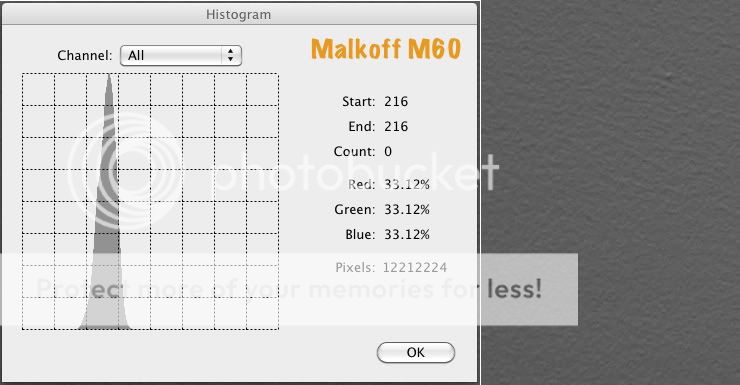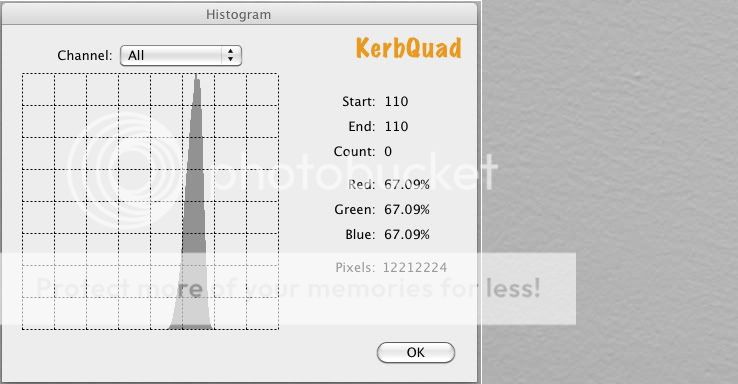Hey guys,
I was messing around with my lights and thinking about sending a box of torches to Chelis for sphere testing and started wondering if there was a way I could do quick and easy, intrumented relative output measurements. So this is what I came up with:
1. set up dSLR against a white wall, fix focus and all exposure settings including ISO, WB, shutter speed, f-number, etc., set camera to monochrome
2. point light up in a dark room and do a ceiling bounce
3. take a snapshot
4. see what image property parameters might scale to perceived output
I did this and eventually settled on the histogram peak. This is what I got.

Here are two examples of the data used to generate the column chart. Histogram on the left, 100% crop from center of frame on the right.


The units themselves don't relate directly to the lights of course. They are just the peaks of the 0-255 luminance histogram. However, they do integrate the visual output in the sense of how bright a wall looks in a relatively small room (my first floor half bath) without differentiating hotspot and corona.
I controlled and standardized a number of things: all lights on freshly charged cells, first measurement one minute post charge termination. Two readings each, taken 10 seconds after turn on, 30 seconds between runs, camera on tripod, torch bezel in fixed location, all multilevel lights on highest output setting, all 18650-type lights used the same cell during test.
Note: Mag11, MagCharger85, Polaris (50W MR), and Aurora (100W) are hotwires.
Some observations:
1. The Nailbender XM-L is an overachiever! Great color, great output, great beam pattern. A fantastic value and, well, great performer.
2. The versatile multilevel Milkyspit Gossamer puts a lot of power in a small package and only gives up a tiny bit to the 2xCR123 single mode KL4 Freak.
3. The Oveready Triple (on 2x18500) performs roughly on par with a custom 50-watt MR16 (Solux 6500K) torch. Again, a startling amount of power in a relatively compact package.
4. A step up in performance, the Kenji Quad DD drop-in is just wow. What can I say, it punches with the big boys throwing a massive fat beam that comes very close to my reference and reliable around the grounds ready light, the MagCharger85. Of course the benefit of the MC85 is that I can keep it in the charge cradle at all times for perpetual readiness.
5. Finally, you can't argue with the watts. The 100W+ Aurora is very bright.
So what do you think? Keep in mind this isn't meant to be rigorous nor will it provide absolute measurements and the method is probably flawed in some ways that I have not anticipated. But it's fast, easy, and matches up pretty well with my perceptions of total output. The big performance variable that is smeared out is, of course, the beam pattern. For example, though comparable in output, the XM-L drop-in significantly out throws the Gossamer.
Wilkey
PS. Go gently on this old guy. I've been out of the game for a while. :laughing:
I was messing around with my lights and thinking about sending a box of torches to Chelis for sphere testing and started wondering if there was a way I could do quick and easy, intrumented relative output measurements. So this is what I came up with:
1. set up dSLR against a white wall, fix focus and all exposure settings including ISO, WB, shutter speed, f-number, etc., set camera to monochrome
2. point light up in a dark room and do a ceiling bounce
3. take a snapshot
4. see what image property parameters might scale to perceived output
I did this and eventually settled on the histogram peak. This is what I got.

Here are two examples of the data used to generate the column chart. Histogram on the left, 100% crop from center of frame on the right.


The units themselves don't relate directly to the lights of course. They are just the peaks of the 0-255 luminance histogram. However, they do integrate the visual output in the sense of how bright a wall looks in a relatively small room (my first floor half bath) without differentiating hotspot and corona.
I controlled and standardized a number of things: all lights on freshly charged cells, first measurement one minute post charge termination. Two readings each, taken 10 seconds after turn on, 30 seconds between runs, camera on tripod, torch bezel in fixed location, all multilevel lights on highest output setting, all 18650-type lights used the same cell during test.
Note: Mag11, MagCharger85, Polaris (50W MR), and Aurora (100W) are hotwires.
Some observations:
1. The Nailbender XM-L is an overachiever! Great color, great output, great beam pattern. A fantastic value and, well, great performer.
2. The versatile multilevel Milkyspit Gossamer puts a lot of power in a small package and only gives up a tiny bit to the 2xCR123 single mode KL4 Freak.
3. The Oveready Triple (on 2x18500) performs roughly on par with a custom 50-watt MR16 (Solux 6500K) torch. Again, a startling amount of power in a relatively compact package.
4. A step up in performance, the Kenji Quad DD drop-in is just wow. What can I say, it punches with the big boys throwing a massive fat beam that comes very close to my reference and reliable around the grounds ready light, the MagCharger85. Of course the benefit of the MC85 is that I can keep it in the charge cradle at all times for perpetual readiness.
5. Finally, you can't argue with the watts. The 100W+ Aurora is very bright.
So what do you think? Keep in mind this isn't meant to be rigorous nor will it provide absolute measurements and the method is probably flawed in some ways that I have not anticipated. But it's fast, easy, and matches up pretty well with my perceptions of total output. The big performance variable that is smeared out is, of course, the beam pattern. For example, though comparable in output, the XM-L drop-in significantly out throws the Gossamer.
Wilkey
PS. Go gently on this old guy. I've been out of the game for a while. :laughing:

